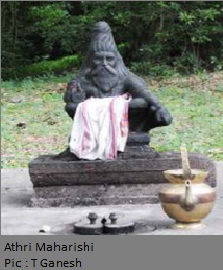Any and all opinions expressed in this newsletter are solely those of the author(s) and do not reflect the opinion of ATREE.
Centre for Excellence in Conservation Science
Royal Enclave,Srirampura,Jakkur Post
Bangalore-560064
Telephone: 080-23635555 (EPABX)
Fax : 080- 23530070
Tucked in the north eastern part of KMTR is
the Athri hills, clad in evergreen forests right
from the base to its higher reaches. This
contrasts the southern parts where low
elevation starts with thorny scrubby jungles.
The gap in the Athri hill range allows more
moisture from the western side to enter the
region all year around which has resulted in
dry evergreen forest even in the lower
elevation. The dry evergreen forest is
considered to be rich in medicinal plants,
which has brought here many ‘siddhars’
(siddha medicine practitioners) in search of
plants for their practice. The access to these
hills is still through a bridle path which
crosses the Kallar river, and the lack of a
good jeepable road so far has kept it away
from the glare of tourists. Legend has it that
Athri Maharishi and his wife Anushiya made
these hills their home, raised their two
children and hence the name Athri hills. It is
also believed that Sage Athri created the
"Ganga River" for his ardent disciple
Korakkanathar in the form of a spring in these
hills. Even today, we see this perennial spring
which bears water all through the year. At the
center of the spring stands a Ganga Devi idol,
which was installed by the Athri followers in
his memory. Although the installation is
estimated to be about 1,200 years old, other
deities have been added over time. The
villagers now call it Murugan temple and the
legend of Athri seems to be slowly fading away. Also, another deity, Karupusamy
whose idol is about five km away from the site
is hardly remembered. In 2004, the quaint
place close to the spring was replaced by a
concrete structure and also got consecrated
with a pompous festival. Chitthirai pournami
(new moon in the first month of the Tamil
year) is the main festival of this temple which
draws 2,500 people who camp inside the
forests for a night. With mounting pressure
from the forest department the camping has
been abandoned recently. Apart from this,
on every full moon and new moon days about
200 to 300 people gather here. With festival comes garbage accumulation.
Fortunately for the forest, the Ulavaarapani
group from Ambasamudram, a nearby town,
along with a few motivated individuals from
V. K. Puram collect the garbage on every
first sunday of the month and move it to the
plains. Strangely, below this temple in a lime
stone cave formation, lies a mosque which
came into existence about 300 years ago.
Today it attracts 2,000 people during Kanthuri
festival. Recently a new mosque was added
close to it. All the devotees visit both holy
shrines without any conflict. However, it is
important to regulate the crowd as any
religious gathering has the natural tendency
to blow out of proportion, as we have learnt
from Sori Muthian Kovil (SMK) and
Sabarimalai. These holy places came into
existence in remote areas for devotees to
experience ‘being removed from their routine
life’ by facing hardships and sacrificing their
luxuries. Today, these values are eroding with
increasing paraphernalia of facilities that are
associated with any popular tourist area. In
addition, this site is being promoted to
encourage increase in commerce. SMK
stands as a testimony for succumbing to such
a trajectory in the landscape. We hope, Athri
hills retains its charm, as the sage had seen
it, for the many years to come.
Editorial Team
Editor: Allwin Jesudasan
Associate editor: Rajkamal Goswami
Editorial Review: R. Ganesan, M. Soubadra Devy, T. Ganesh
Design and presentation: Kiran Salegame
A S H O K A T R U S T F O R R E S E A R C H I N E C O L O G Y A N D T H E E
N V I R O N M E N T
Fading trail of Athri Maharishi …
-M Soubadra Devy
If you have any suggestions or comments please let us know through the boxes below






